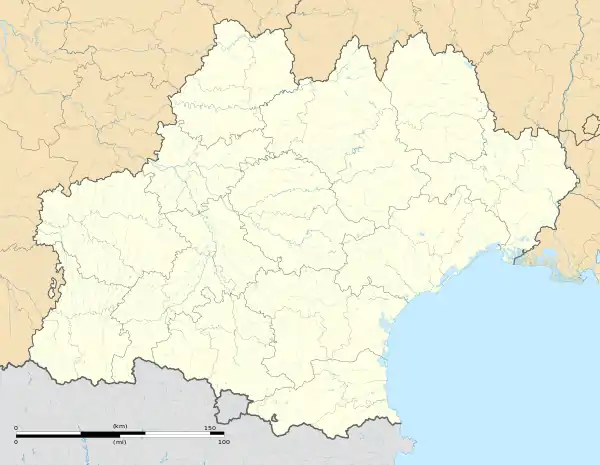Lunel, Hérault
Lunel (Provençal: Lunèl) is a commune in the Hérault department in southern France. According to legend, Lunel was founded by Jews from Jericho in the first century.[3] It had a Jewish population by the first millennium, and an ancient synagogue is located there.

Lunel | |
|---|---|
 Town hall | |
.svg.png.webp) Coat of arms | |
Location of Lunel 
| |
 Lunel  Lunel | |
| Coordinates: 43°40′40″N 4°08′10″E | |
| Country | France |
| Region | Occitanie |
| Department | Hérault |
| Arrondissement | Montpellier |
| Canton | Lunel |
| Intercommunality | Pays de Lunel |
| Government | |
| • Mayor (2020–2026) | Pierre Soujol[1] |
| Area 1 | 23.90 km2 (9.23 sq mi) |
| Population (2017-01-01)[2] | 26,239 |
| • Density | 1,100/km2 (2,800/sq mi) |
| Time zone | UTC+01:00 (CET) |
| • Summer (DST) | UTC+02:00 (CEST) |
| INSEE/Postal code | 34145 /34400 |
| Elevation | 2–53 m (6.6–173.9 ft) |
| 1 French Land Register data, which excludes lakes, ponds, glaciers > 1 km2 (0.386 sq mi or 247 acres) and river estuaries. | |
Lunel is located 21 km (13 mi) east of Montpellier and 28 km (17 mi) southwest of Nîmes (Gard).
History
The ancient Roman site of Ambrussum is located nearby. The troubadour Folquet de Lunel was from Lunel.
Lunel was a centre of Jewish learning. It is thought that the family of Rashi (1040–1105), the great Rabbi and commentator, originated in Lunel. Other scholars include Jonathan of Lunel, Meshullam ben Jacob of Lunel, his son Aaron ben Meshullam ben Jacob of Lunel, Abraham ben David who taught in Lunel before moving to Posquières, and Asher ben Meshullam of Lunel.
Lunel was the birthplace of Louis Feuillade (1873–1925), film director from the silent era. The artist Jean Hugo (1894-1984) lived in the Lunel area for most of his life and painted scenes from the surrounding countryside. The Parc Jean Hugo in the centre of the town was named after him.
Since the 20th century, the town has been a destination for Muslim immigrants from Algerian and other parts of North Africa. In 2015 the New York Times reported that 10% of all the French people killed fighting in Syria for ISIS came from Lunel.[4]
Population
|
|
References
- "Répertoire national des élus: les maires". data.gouv.fr, Plateforme ouverte des données publiques françaises (in French). 2 December 2020. Retrieved 11 December 2020.
- "Populations légales 2017". INSEE. Retrieved 6 January 2020.
- Farber, J.B. (2013). The Pope's Jews in Provence: Itineraries. Arles: Editions Actes Sud. ISBN 2330018975.
- "A French Town Linked to Jihad Asks Itself Why", New York Times, January 2015